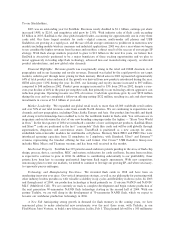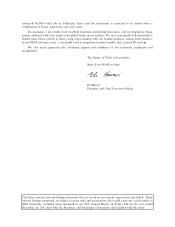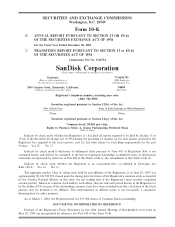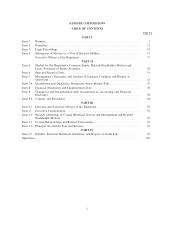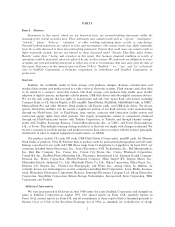SanDisk 2003 Annual Report Download - page 12
Download and view the complete annual report
Please find page 12 of the 2003 SanDisk annual report below. You can navigate through the pages in the report by either clicking on the pages listed below, or by using the keyword search tool below to find specific information within the annual report.xD Picture Card. In 2003, we began selling the xD-Picture card format under our arrangements with
Olympus and Fuji for use in cameras from Olympus and Fuji. The xD-Picture card allows for rapid data
transfer, is ultra compact for the most portable device and is compatible with all xD cameras. The xD-Picture
card is available in capacities that range from 64 megabytes to 512 megabytes.
Viewers, Readers and Adapters. In January 2003, we announced our Digital Photo Viewer, or DPV.
The DPV supports 6 media formats and allows pictures taken with a digital camera to be quickly and easily
viewed on most televisions. We oÅer a broad line of memory card readers, which provide a fast, convenient
way to transfer data between our memory card products and a personal computer through a USB connection.
Our premium 8-in-1 USB 2.0 reader supports CF type I and type II, MultiMediaCard, SD card,
MemoryStick, MemoryStick PRO, SmartMedia and xD-Picture card. We also oÅer a 4-in-1 PC Card adapter
that enables consumers to transfer data from consumer devices to a notebook computer. The 4-in-1 adapter
supports MultiMediaCard, SD card, SmartMedia and MemoryStick formats. We also oÅer a low priced CF
adapter.
TriFlash. TriFlash is a high capacity, small, embedded Öash memory device. TriFlash is designed for
storing audio, video, data and images on small portable systems. These products are targeted at Internet music
players and cell phones. TriFlash will give product manufacturers the option of either using TriFlash and/or
removable Öash memory cards in their consumer electronics products. TriFlash is available in 16, 32 and
64 megabyte capacities.
T-Flash. Our recently announced T-Flash is a very small transportable memory module used in mobile
phones to store multimedia content and data. The very small size makes it ideal for inclusion in small mobile
phone designs. T-Flash modules come in 16 megabyte up to 128 megabyte capacities and allow users to
upgrade the memory capacity of their phone or to migrate data between phones. Motorola announced that it
plans to use T-Flash in several of its multimedia camera cell phones to be introduced in the second half of
2004.
Technology
Since our inception, we have focused our research, development and standardization eÅorts on developing
highly reliable, high-performance and cost-eÅective Öash memory storage products to address a variety of
emerging markets. We have been actively involved in all aspects of this development, including Öash memory
process development, chip design, controller development and system-level integration to ensure the creation
of fully-integrated, broadly interoperable products that are compatible with both existing and newly developed
system platforms. In 2000, we entered into a long-term strategic partnership with Toshiba to jointly develop
and manufacture advanced NAND Öash memory components to be used in our products. We believe our core
technical competencies are in high-density Öash memory process and design, controller design, system-level
integration, compact packaging and low-cost system testing. We have also initiated, deÑned and developed
new standards such as CF card, MultiMediaCard, SD card, miniSD card, and Memory Stick Pro cards, as
well as new modules such asT-Flash, to meet new market needs and to promote wide acceptance of the
standards through interoperability and ease-of-use.
To achieve compatibility with various electronic platforms regardless of the host processors or operating
systems used, we developed new capabilities in Öash memory chip design and created intelligent controllers.
We also developed an architecture that can leverage advances in process technology designed to ensure a
scaleable, high-yielding, cost-eÅective and highly reliable manufacturing process. We believe that these
technical competencies and our system design approach have enabled us to introduce Öash data storage
products that are better suited for our target markets than linear Öash cards based on socket Öash chips. We
design our products to be compatible with industry-standard IDE, ATA, MultiMediaCard, SD and Memory
Stick interfaces used in all standard operating systems, or OS, Windows XP and Apple OS X compatible
personal computers, and operating systems used in cell phones, PDAs, and other consumer and industrial
products.
Our patented intelligent controller with its advanced defect management system permits our products to
achieve a high level of reliability and longevity. Latent bit failure can occur several years into the life of a Öash
8


